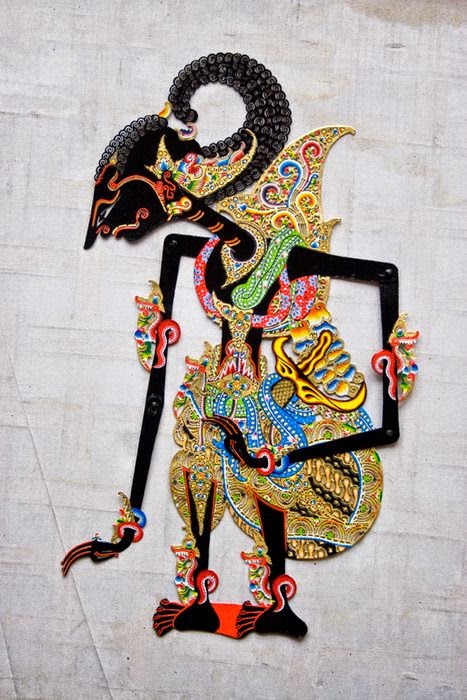 |
| Wayang |
Wayang is an ancient Javanese word meaning “shadow” or “ghost.” It is also the name for the traditional sacred dramas of Java and Bali. There are seven main forms of wayang, but wayang kulit, or shadow-puppet theater, is the most common.
In Java, shadow plays are performed to celebrate public holidays, religious festivals, weddings, birth celebrations, and circumcisions. In Bali, they are staged at all these events, as well as at cremations.
Wayang Kulit
The wayang kulit may have originated in Java thousands of years ago. Wayang kulit stories are told with flat puppets made of leather and cut out in profile. These shadow puppets are beautifully painted and intricately pierced so that their shadows are amazingly detailed. The puppets’ arms are moved by manipulating small sticks.
 |
| Wayang kulit |
The puppeteer is called the dalang. He sits cross-legged behind the screen, which is usually a large white cloth stretched on a wooden frame. An oil lamp hangs above the puppeteer so that as he moves the puppets the lamp casts their shadows onto the screen.
Shadow plays generally are extensive events. In its entirety, a typical wayang kulit may last from sundown until sunrise, about eight or nine hours. Not only must the dalang be a trained performer, but he has to be strong and in excellent health as well.
During the full nine hours, he must remain cross-legged, moving only to control the puppets and the kechrek, or rattle, which he constantly strikes with his right foot.
 |
| gamelan instruments |
The dalang speaks for all the puppets and has to be able to change his voice to portray every type of character. A shadow play is always accompanied by a gamelan, a traditional Indonesian orchestra, which is made up mostly of metal percussion instruments. The dalang also acts as conductor, giving hidden cues to the gamelan musicians.
Two Forms of Wayang Kulit
There are two subcategories of wayang kulit. The older form is wayang purwa, in which stories from the two great Indian epics, the Mahabharata and the Ramayana, are told. Both of these epics arrived in Java with the influx of Indian influence in the first century C.E.
There are about 200 different lakon, or stories, based on what are now truly Javanese versions of the tales within those two epics. In Java, the Pendawa cycle was inspired by the Mahabharata, and the Rama cycle by the Ramayana.
 |
| Mahabharata |
Perhaps the most popular stories in the Rama cycle are those concerning the marriage of Rama to Sinta (Sita in the Ramayana) and Sinta’s abduction and rescue.
The second form of wayang kulit is called wayang gedog. In this type, stories from the later Hindu era of Java are retold. They feature tales of a mythological hero-prince, Panji. Wayang gedog is rarely performed today.
Puppet shows on nonmythic themes are less common. Those that are performed include wayang golek, which uses round puppets carved of wood, and wayang wong, dance dramas performed by live actors.
 |
| Wayang golek |